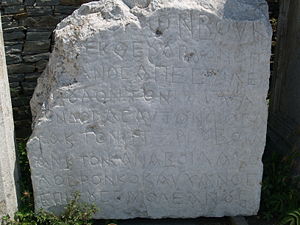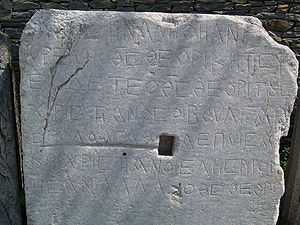
Presian Inscription
Encyclopedia


Medieval Greek
Medieval Greek, also known as Byzantine Greek, is the stage of the Greek language between the beginning of the Middle Ages around 600 and the Ottoman conquest of the city of Constantinople in 1453. The latter date marked the end of the Middle Ages in Southeast Europe...
text inscribed upon a stone in Philippi
Philippi
Philippi was a city in eastern Macedonia, established by Philip II in 356 BC and abandoned in the 14th century after the Ottoman conquest...
during the reign of the Bulgarian
First Bulgarian Empire
The First Bulgarian Empire was a medieval Bulgarian state founded in the north-eastern Balkans in c. 680 by the Bulgars, uniting with seven South Slavic tribes...
ruler Presian I (r. 836–852).
Background history
In 837, soon after Presian's accession, the Slavs in the vicinity of Thessalonica rebelled against the Byzantine EmpireByzantine Empire
The Byzantine Empire was the Eastern Roman Empire during the periods of Late Antiquity and the Middle Ages, centred on the capital of Constantinople. Known simply as the Roman Empire or Romania to its inhabitants and neighbours, the Empire was the direct continuation of the Ancient Roman State...
. Emperor Theophilos
Theophilos (emperor)
Theophilos was the Byzantine emperor from 829 until his death in 842. He was the second emperor of the Phrygian dynasty, and the last emperor supporting iconoclasm...
sought Bulgarian support in putting down the rebellion, but simultaneously arranged for his fleet to sail through the Danube
Danube
The Danube is a river in the Central Europe and the Europe's second longest river after the Volga. It is classified as an international waterway....
delta and undertake a clandestine evacuation of some of the Byzantine captives settled in trans-Danubian Bulgaria by the Bulgarian rulers Krum
Krum of Bulgaria
Krum the Horrible was Khan of Bulgaria, from after 796, but before 803, to 814 AD. During his reign the Bulgarian territory doubled in size, spreading from the middle Danube to the Dnieper and from Odrin to the Tatra Mountains. His able and energetic rule brought law and order to Bulgaria and...
and Omurtag. In retaliation the kavhan Isbul
Isbul
Isbul was the kavhan, or first minister, of the First Bulgarian Empire during the reigns of Omurtag, Malamir and Presian I...
campaigned along the Aegean
Aegean Sea
The Aegean Sea[p] is an elongated embayment of the Mediterranean Sea located between the southern Balkan and Anatolian peninsulas, i.e., between the mainlands of Greece and Turkey. In the north, it is connected to the Marmara Sea and Black Sea by the Dardanelles and Bosporus...
coasts of Thrace
Thrace
Thrace is a historical and geographic area in southeast Europe. As a geographical concept, Thrace designates a region bounded by the Balkan Mountains on the north, Rhodope Mountains and the Aegean Sea on the south, and by the Black Sea and the Sea of Marmara on the east...
and Macedonia
Macedonia (region)
Macedonia is a geographical and historical region of the Balkan peninsula in southeastern Europe. Its boundaries have changed considerably over time, but nowadays the region is considered to include parts of five Balkan countries: Greece, the Republic of Macedonia, Bulgaria, Albania, Serbia, as...
and captured the city of Philippi
Philippi
Philippi was a city in eastern Macedonia, established by Philip II in 356 BC and abandoned in the 14th century after the Ottoman conquest...
, where he set up a surviving memorial inscription in a local church. Isbul's campaign may also have resulted in the establishment of Bulgarian suzerainty
Suzerainty
Suzerainty occurs where a region or people is a tributary to a more powerful entity which controls its foreign affairs while allowing the tributary vassal state some limited domestic autonomy. The dominant entity in the suzerainty relationship, or the more powerful entity itself, is called a...
over the local Slavic tribe of the Smolyani
Smolyani
The Smolyani were a medieval Slavic tribe that settled in the Rhodope Mountains, the valley of the Mesta River and the region around Blagoevgrad Province, possibly in the 7th-8th century...
.

